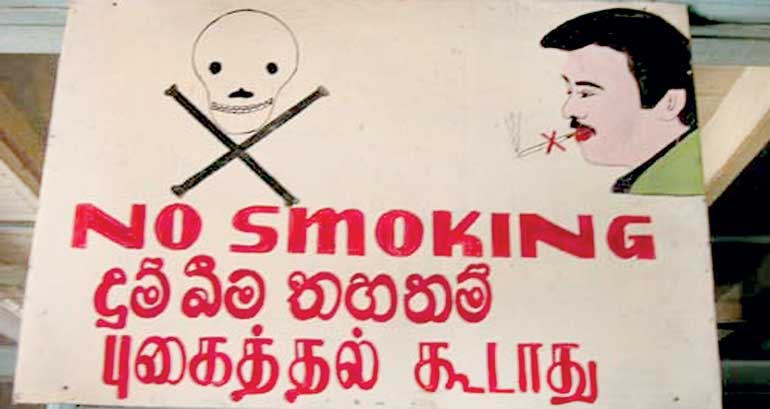Saturday Apr 20, 2024
Saturday Apr 20, 2024
Tuesday, 21 February 2017 00:00 - - {{hitsCtrl.values.hits}}
By Janaka Amarasekera
US President Donald Trump chose Tom Price to direct his Government’s health policy, and just like many other appointments, Price drew criticism for his alleged close links with the tobacco industry. The new Health and Human Services Secretary is said to have repeatedly voted against bills that could harm big tobacco, and is alleged to have received thousands of dollars in political contributions from the industry.
Previously, during the Obama administration, Congress passed the Family Smoking Prevention and Tobacco Control Act, empowering the Food and Drug Administration to regulate tobacco products enabling it to ban certain flavoured cigarettes that might entice youth to start smoking, plus, introduce additional warnings. Most Republicans voted against this bill, but with it Price will now wield immense influence over the operations of the tobacco trade.
Plain packaging
Across the Atlantic over in the UK, tobacco companies lobbied hard to prevent the introduction of plain packaging for cigarette packs – but this was rejected by the Court of Appeal very recently. By shifting packaging to boxes indistinguishable from each other, save the brand name on the pack, regulators hope to reduce appeal for the uptake of smoking, coupled with greater prominence to health warnings.
Nicola Blackwood, Britain’s Public Health and Innovation Minister, said: “Standardised packaging will help cut smoking rates and reduce suffering, disease and loss of life. We are pleased that this decision will help many people to lead longer and healthier lives.”
Plain packaging was first introduced in Australia with the same stated objectives. However, with smoking remaining an informed adult choice and purchase decision the world over, what change has it delivered to consumers? Three years later, pointing to a statistical reduction in smoking by 0.55% (110,000 smokers), the Australian Government claims plain packaging is working well.
Is plain packaging a deterrent to smoking? It is not. It only serves to quell its appeal via colourful packaging. The process to stop people from smoking and to take up the habit must follow a more informative and education-based approach targeting children and young adults. The ill-effects of smoking are engrained in us at a very young age, and consumption remains an adult choice and continues despite plain packaging.
The tobacco industry worldwide argues there is no evidence to suggest a link between the appeal of packs and smoking rates. They attribute the drop in tobacco consumption in Australia since 2012 to increases in excise duty and other health education policies. They also cite a KPMG study showing the consumption of illicit tobacco in Australia has risen to 14% of the overall market from 11.5% in 2012, as plain packaging removes trademarks and brand-led defences.
Sri Lanka
Here in Sri Lanka, graphic health warnings adorn 80% of cigarette packs educating and informing consumers on the harmful health effects of smoking. Smoking is banned in public places, plus, no sales of cigarettes to those under 21 years of age. Several anti-smoking campaigns are also broadcast repeatedly over local media. In the last quarter, the Government raised cigarette prices over 40%, which resulted in a reduction in volumes by 45% according to a statement by the country’s sole manufacturer of tobacco products.
With a high level of information and education amongst students and youth on the ill-effects of smoking, complimented by the actions listed above, Sri Lankan sits high amongst the list of countries taking stringent action against tobacco. However, it must guard against over-regulation as such incidence can exacerbate the illicit menace, which already results in over Rs. 5 billion in losses to the Government annually. With high prices, Sri Lanka has now emerged a hot spot and target for the global illicit tobacco trade, and what the Government must focus on now is to enforce measures to prevent a spread of the growth of illicit.
A study of the world’s tobacco control map would show that except Greenland, Burma and parts of Central Africa, every country has put in place a series of measures to effectively control the sale, promotion and consumption of tobacco products. Sri Lanka’s tobacco control regulations are far ahead of those seen in countries like India, Japan and Indonesia, reaffirming the need to now focus on enforcement against illicit and emerging new products.
The regulatory framework must now evolve to cover novel nicotine products such as e-cigarettes and nicotine delivery systems, which claim to reduce harm to consumers and even second-hand smokers. With many smokeless tobacco products now in the market, claiming to be safer substitutes to cigarettes, governments and health administrators will need to invest research and resources to validate these clams and be ready to take on the next wave of tobacco action. Regulations could also look at disposal to minimise the harm on the environment.
Benchmark for the region
Sri Lanka will no doubt be proud of its achievements in the sphere of tobacco control, and has served as a benchmark for the rest of the region in its efforts in this sphere. It must now evolve to the next level of enforcement and take a lead in combatting the spread of illicit, which is a growing trend all over the world. Over 100 million illicit sticks are reportedly consumed every year in Sri Lanka, with growing interest from smugglers. The President, from the time of his tenure as Health Minister, has spearheaded the anti-tobacco movement, and we look forward to his continued efforts and support to combat the illicit trade. A world free from tobacco remains an impossible dream, but a world spread with effective tobacco control is within reach, and Sri Lanka is in the lead.